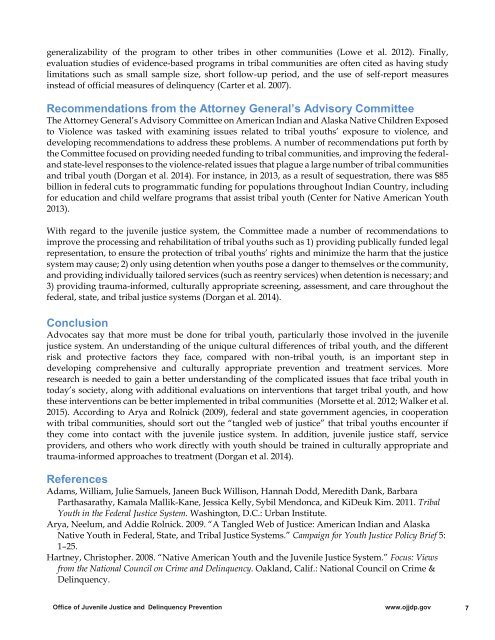Native American Youth In The Juvenile Justice System
Native American Youth In The Juvenile Justice System
Native American Youth In The Juvenile Justice System
You also want an ePaper? Increase the reach of your titles
YUMPU automatically turns print PDFs into web optimized ePapers that Google loves.
generalizability of the program to other tribes in other communities (Lowe et al. 2012). Finally,<br />
evaluation studies of evidence-based programs in tribal communities are often cited as having study<br />
limitations such as small sample size, short follow-up period, and the use of self-report measures<br />
instead of official measures of delinquency (Carter et al. 2007).<br />
Recommendations from the Attorney General’s Advisory Committee<br />
<strong>The</strong> Attorney General’s Advisory Committee on <strong>American</strong> <strong>In</strong>dian and Alaska <strong>Native</strong> Children Exposed<br />
to Violence was tasked with examining issues related to tribal youths’ exposure to violence, and<br />
developing recommendations to address these problems. A number of recommendations put forth by<br />
the Committee focused on providing needed funding to tribal communities, and improving the federaland<br />
state-level responses to the violence-related issues that plague a large number of tribal communities<br />
and tribal youth (Dorgan et al. 2014). For instance, in 2013, as a result of sequestration, there was $85<br />
billion in federal cuts to programmatic funding for populations throughout <strong>In</strong>dian Country, including<br />
for education and child welfare programs that assist tribal youth (Center for <strong>Native</strong> <strong>American</strong> <strong>Youth</strong><br />
2013).<br />
With regard to the juvenile justice system, the Committee made a number of recommendations to<br />
improve the processing and rehabilitation of tribal youths such as 1) providing publically funded legal<br />
representation, to ensure the protection of tribal youths’ rights and minimize the harm that the justice<br />
system may cause; 2) only using detention when youths pose a danger to themselves or the community,<br />
and providing individually tailored services (such as reentry services) when detention is necessary; and<br />
3) providing trauma-informed, culturally appropriate screening, assessment, and care throughout the<br />
federal, state, and tribal justice systems (Dorgan et al. 2014).<br />
Conclusion<br />
Advocates say that more must be done for tribal youth, particularly those involved in the juvenile<br />
justice system. An understanding of the unique cultural differences of tribal youth, and the different<br />
risk and protective factors they face, compared with non-tribal youth, is an important step in<br />
developing comprehensive and culturally appropriate prevention and treatment services. More<br />
research is needed to gain a better understanding of the complicated issues that face tribal youth in<br />
today’s society, along with additional evaluations on interventions that target tribal youth, and how<br />
these interventions can be better implemented in tribal communities (Morsette et al. 2012; Walker et al.<br />
2015). According to Arya and Rolnick (2009), federal and state government agencies, in cooperation<br />
with tribal communities, should sort out the “tangled web of justice” that tribal youths encounter if<br />
they come into contact with the juvenile justice system. <strong>In</strong> addition, juvenile justice staff, service<br />
providers, and others who work directly with youth should be trained in culturally appropriate and<br />
trauma-informed approaches to treatment (Dorgan et al. 2014).<br />
References<br />
Adams, William, Julie Samuels, Janeen Buck Willison, Hannah Dodd, Meredith Dank, Barbara<br />
Parthasarathy, Kamala Mallik-Kane, Jessica Kelly, Sybil Mendonca, and KiDeuk Kim. 2011. Tribal<br />
<strong>Youth</strong> in the Federal <strong>Justice</strong> <strong>System</strong>. Washington, D.C.: Urban <strong>In</strong>stitute.<br />
Arya, Neelum, and Addie Rolnick. 2009. “A Tangled Web of <strong>Justice</strong>: <strong>American</strong> <strong>In</strong>dian and Alaska<br />
<strong>Native</strong> <strong>Youth</strong> in Federal, State, and Tribal <strong>Justice</strong> <strong>System</strong>s.” Campaign for <strong>Youth</strong> <strong>Justice</strong> Policy Brief 5:<br />
1–25.<br />
Hartney, Christopher. 2008. “<strong>Native</strong> <strong>American</strong> <strong>Youth</strong> and the <strong>Juvenile</strong> <strong>Justice</strong> <strong>System</strong>.” Focus: Views<br />
from the National Council on Crime and Delinquency. Oakland, Calif.: National Council on Crime &<br />
Delinquency.<br />
Office of <strong>Juvenile</strong> <strong>Justice</strong> and Delinquency Prevention www.ojjdp.gov 7

















